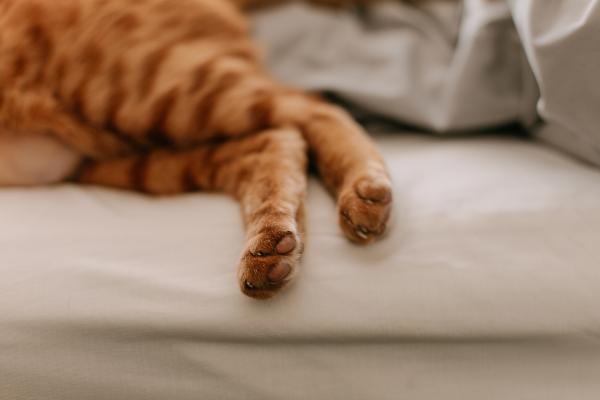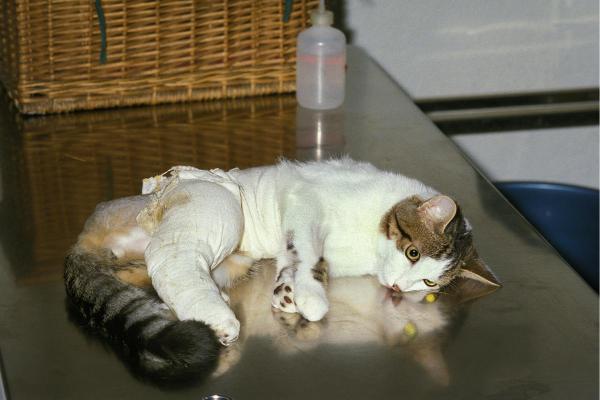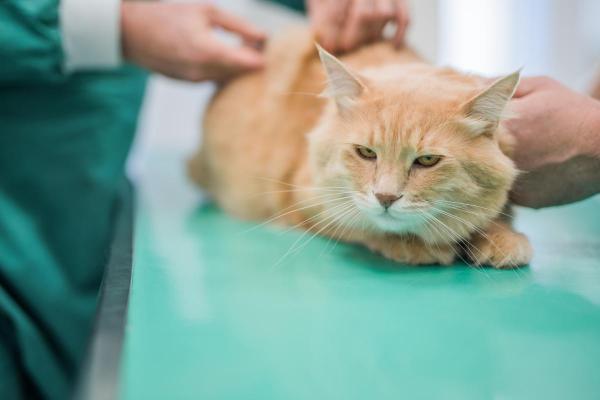Why Your Cat’s Back Legs Are Weak



See files for Cats
Have you noticed your cat walking strangely with its back legs? Maybe your cat can't support itself on its hind legs or is dragging its back legs? Vets call this condition "ataxia" when it affects the back legs. While that sounds technical, it simply means your cat is having trouble coordinating their hind limbs. This can happen for several different reasons, and knowing what might be causing it can help you get the right help for your cat.
If you're wondering why your cat's back legs aren't working properly, keep reading this AnimalWised article to learn about the main causes and treatments.
1. Spinal problems
One of the main reasons your cat's back legs might not be working properly is an issue with their spine. Just like in humans, a cat's spine protects vital nerve pathways that control movement. When something interferes with these pathways it can affect how your cat walks.
You might notice your cat wobbling, having trouble jumping onto furniture, or crossing their back legs oddly when walking. Some cats fall frequently or drag one or both back legs when the spine is involved. Cats with spinal issues may also become reluctant to play or move around much, and some might show signs of pain when touched along their back. The changes might happen gradually or suddenly, depending on what's causing the problem.
Spinal problems vary widely in severity. Some cats might have a temporary inflammation that resolves with treatment, while others might have degenerative conditions that need ongoing management. Older cats are more prone to age-related spinal issues, but even young cats can develop spinal problems from injuries or congenital conditions they were born with.
Treatment:
Treatment depends on what's causing the spinal issue. Your vet might prescribe anti-inflammatory medications to reduce swelling or pain relievers to keep your cat comfortable. For more serious cases, surgery might be needed.
Many cats benefit from gentle physical therapy regardless of the cause. Some cats respond well to complementary treatments like acupuncture, especially for chronic conditions.
Spinal issues are a common cause of mobility problems in cats. Dive deeper into the various conditions affecting your cat's vertebral column in our other article.
2. Blood clots
If your cat suddenly loses the ability to use their back legs, a blood clot could be the culprit. This serious condition, called aortic thromboembolism, happens when a clot blocks blood flow to the back legs, cutting off oxygen and nutrients to the muscles and nerves.
Besides not being able to use their back legs, you'll likely notice your cat showing signs of pain. Their back paws might feel cooler than the front ones, and in some cases, the pads might look bluish. This often happens in cats with heart disease, which makes them prone to forming clots. Some cats might cry out in pain when the clot first forms, and many will pant or breathe rapidly due to both pain and the underlying heart condition.
This condition can be particularly confusing for owners because it looks like an injury, but there's no trauma involved. It's important to know that unlike a simple sprain or strain, a blood clot cutting off circulation to the legs is life-threatening and requires immediate attention
Treatment:
This is an emergency situation requiring immediate vet care. Treatment focuses on controlling pain, trying to address the clot, and treating any underlying heart condition. Your vet will likely use strong pain medications and blood-thinning drugs to help your cat through this crisis.
Recovery depends on how quickly treatment begins and the severity of any underlying heart disease. For cats who survive the initial crisis, medications to prevent future clots are usually prescribed, along with treatment for heart disease if present.
3. Trauma
Cats are natural climbers and jumpers, but sometimes these adventures lead to injuries. Falls, car accidents, or other traumatic events can damage your cat's spine or legs, affecting their ability to walk normally. Even what seems like a minor incident can sometimes cause significant damage, as cats often hide signs of pain or injury.
After an injury, you might see your cat stumbling, moving cautiously, or refusing to jump. They might show pain when you touch certain areas of their back, or they might drag one or both back legs. Severe injuries can even cause problems with bladder or bowel control.
Some injuries involve simple soft tissue damage that heals with time, while others might include fractures or dislocations that require more intensive intervention. Cats typically have amazing healing abilities, but spinal injuries can be particularly serious because they might affect the nerves controlling movement and bodily functions.
Treatment:
Minor injuries might just need rest and pain relief, which your vet can prescribe. More serious injuries could require surgery. Either way, keeping your injured cat comfortable and limiting their activity while they heal is important. Many cats recover well from injuries with proper care and a little time.
Your vet might recommend creating a small, contained recovery space to limit jumping and climbing during healing. Gentle physical therapy, once your vet approves it, can help restore strength and coordination.

4. Nerve and muscle issues
Sometimes the problem isn't with your cat's spine but with the nerves that run from the spine to the legs, or with the muscles themselves. These issues can cause weakness or poor coordination even when the spine looks normal on tests. Nerve and muscle problems may develop from metabolic disorders, nutritional imbalances, infections, toxin exposure, or immune-mediated conditions.
Cats with nerve or muscle problems often show progressive weakness in their back legs. You might notice them walking flat-footed on their back paws (when normally cats walk on their toes), or their back legs might tremble after activity.
Cats with diabetes can develop nerve problems, and certain infections or toxins can also affect the nerves and muscles. Potassium deficiency, which sometimes happens with kidney disease, can cause muscle weakness that looks similar.
Treatment:
Treatment depends on finding the underlying cause. For example, diabetic cats need better blood sugar control, while cats with certain deficiencies might need supplements.
Physical therapy is especially helpful for these conditions, helping maintain muscle strength while the underlying issue is being addressed. For inflammatory conditions, immunosuppressive medications might be needed. Even with treatment, some cats might have residual weakness, but many can maintain a good quality of life with appropriate management of their condition.
Curious about the neurological conditions affecting feline mobility? Our other article explores coordination disorders in cats, their various causes, clinical signs, and the latest treatment approaches.
5. Tumor
For older cats especially, tumors affecting the nervous system can cause back leg weakness. These growths can press on the spinal cord or nerves, interfering with normal leg function. While the word "tumor" sounds frightening, it's important to know that not all tumors are malignant, and even when they are, many cats respond well to treatment.
The signs often develop gradually. Your cat might seem a little clumsy at first, then progressively lose strength or coordination in their back legs. Some cats with tumors also have changes in behavior or appetite as the condition progresses. You might notice your cat becoming less active or having trouble using the litter box. Weight loss can be another sign, especially with certain types of cancer.
The most common tumor affecting spinal function in cats is lymphoma, which can occur at any age but is more common in middle-aged to older cats. Meningiomas (tumors of the tissue covering the brain and spinal cord) are also relatively common and are usually benign.
Treatment:
Treatment options include surgery, radiation, or chemotherapy, depending on the type and location of the tumor. For some cats, especially older ones with multiple health issues, focusing on quality of life through pain management might be the best approach.
Your vet can help you understand the options and make the best choice for your cat's specific situation. Many cats, especially those with lymphoma, respond well to chemotherapy protocols that are much gentler than those used in humans. For accessible tumors, surgical removal can sometimes provide complete resolution.
Did you know that nearly 50% of cats over 10 years old may develop certain types of growths? Learn how to identify warning signs and understand treatment possibilities in our other article.

This article is purely informative. AnimalWised does not have the authority to prescribe any veterinary treatment or create a diagnosis. We invite you to take your pet to the veterinarian if they are suffering from any condition or pain.
If you want to read similar articles to Why Your Cat’s Back Legs Are Weak, we recommend you visit our Other health problems category.
- International Cat Care. (2022). Ataxia and weakness in cats. https://icatcare.org/advice/ataxia-and-weakness/
Volk, H. A., & Rusbridge, C. (2021). BSAVA manual of canine and feline neurology (5th ed.). British Small Animal Veterinary Association. https://www.bsava.com/product/bsava-manual-of-canine-and-feline-neurology-5th-edition/







